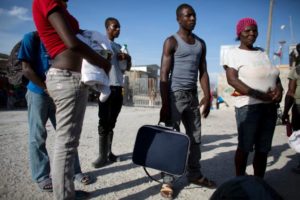
Ten months later, things are looking up. Germain, her husband and three children have been relocated to a cinderblock shack in the nearby Haitian border town of Anse-a-Pitres. They lack running water and electricity, but they are no longer in a forlorn camp of Haitians and people of Haitian descent who have fled or were expelled in a Dominican crackdown on migrants.
“I think life will be better for us here,” Germain said as she watched her youngest daughters play in the backyard with several banana and papaya trees and enough space for a small vegetable plot.
Their move comes amid efforts to cope with an influx of people from across the border setting up tent camps similar to those that aid groups and the government spent years trying to clear out after Haiti’s devastating 2010 earthquake.
Within the next month, authorities hope to move nearly 2,400 people out of six encampments by providing subsidies for them to rent homes for a year in southeastern Haiti. The International Organization for Migration is coordinating the effort with $2 million from a U.N. emergency fund.
“We’re seeing that they move to houses for a year to give them enough time to identify economic opportunities so they can support themselves,” said Fabien Sambussy, the IOM’s operations chief in Haiti.
The border camps, with clusters of makeshift shacks that bake in the sun and flood when it rains, are filled with destitute migrants who often speak a mix of Haitian Creole and Spanish. More than half are children, and health authorities feared that a growing number of cholera cases would turn into a more widespread outbreak.
The camps emerged on the outskirts of Anse-a-Pitres last June as increasing numbers of people left the Dominican Republic. A few thousand people found nowhere to go in Haiti, often because they had been gone so long they didn’t have the social connections needed to survive on the poorer side of the island of Hispaniola.
Germain, 32 and pregnant, fit that category. Her parents went to the Dominican Republic to work in farming when she was 6. The family settled in a shantytown near La Ceiba.
“Life was hard in Haiti, but life was hard in the Dominican, too,” she said.
Her parents, who have since died, never got legal residency for their children. The Dominican Republic, which has long had an uneasy relationship with its much poorer neighbor, has become much less hospitable to its migrants.
Over the last several years, Dominican authorities have begun trying to bolster the largely porous border with Haiti, increasing security at the main crossing points and deporting people who can’t prove legal residency.
Read more at www.sfgate.com

